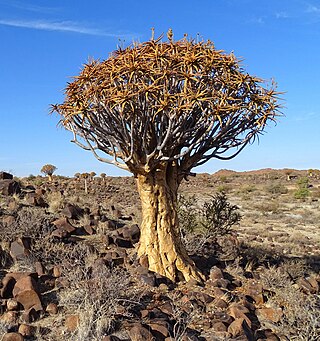
Aloidendron dichotomum, formerly Aloe dichotoma, the quiver tree or kokerboom, is a tall, branching species of succulent plant, indigenous to Southern Africa, specifically in the Northern Cape province of South Africa, and parts of Southern Namibia.

Aloidendron pillansii, formerly Aloe pillansii, the giant quiver tree or bastard quiver tree, is a large, branching species of succulent plant indigenous to southern Africa. It is regarded as critically endangered.

In botany, succulent plants, also known as succulents, are plants with parts that are thickened, fleshy, and engorged, usually to retain water in arid climates or soil conditions. The word succulent comes from the Latin word sucus, meaning "juice" or "sap".

Cheiridopsis denticulata is a species in the genus Cheiridopsis native to South Africa. It has yellow flowers, and distinctive foliage with a narrow, upward curving shape. Commonly called "pink fingers", the leaves grow in opposite pairs and are light blue with sun exposure blushing them shades of pink and purple.

Aloe humilis, also known as spider aloe is a species of succulent plant in the genus Aloe. It is endemic to South Africa's Cape Province, and is a low growing, short stemmed aloe with small spines and which grows in dense clusters.

Haworthia parksiana is a species of succulent plant native to the Western Cape of South Africa. Regarded as the smallest and one of the rarest types of Haworthia in the wild, it is thought to be most closely related to Haworthia floribunda. It grows in rosettes up to about 4 centimetres (1.6 in) in diameter, and is often hidden in the ground.

Haworthia mutica is a species of succulent plant native to South Africa's Cape Province. Very similar to, and often confused with, types such as Haworthia retusa, the species has blunt, triangular shaped leaves that are typically striated. In the wild it rarely offsets, though clones in cultivation may do so readily. The variety H. mutica var nigra is similar but with darker leaf color.

Haworthia chloracantha is a species of succulent plant native to the Cape Province of South Africa. H. chloracantha has typically pale yellow-green leaves and is somewhat similar to Haworthia reticulata in form, but the leaves are opaque rather than translucent. It forms prolific clusters of plants. The plant has a few subvarieties including var. denticulifera, meaning has small teeth on its leaves, and var. subglauca, which has darker foliage.

Haworthia lockwoodii is a species of succulent plant in the genus Haworthia. Native to the Cape Province of South Africa, it was named for a local magistrate.

Haworthia floribunda is a species of succulent plant in the genus Haworthia native to the Cape Province of South Africa. It grows in rosettes with dark green, lanceolate leaves that curve or twist outward. The leaves may be smooth or, in H. floribunda var. dentata, have small teeth.
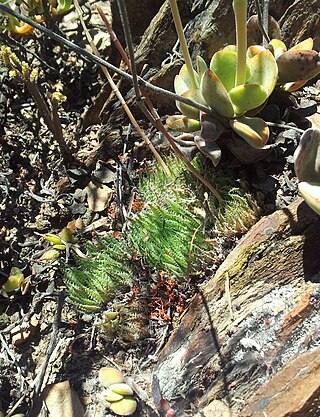
Haworthia herbacea is a species of succulent plant in the genus Haworthia native to the Cape Province of South Africa. Closely related to Haworthia reticulata, it has greenish yellow leaves with small spines. As it matures the leaves get darker green and the white spots raise. Flowers by way of a shoot and produces a large off-white flower.
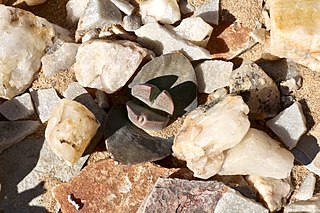
Cheiridopsis peculiaris is a species of succulent plant in the genus Cheiridopsis native to South Africa. Its name refers to the peculiar leaf shape compared to other species in its genus. Like other Cheiridopsis it has leaf pairs, but unusually the outer pair grows flat along the ground while the other pair faces toward the sky.
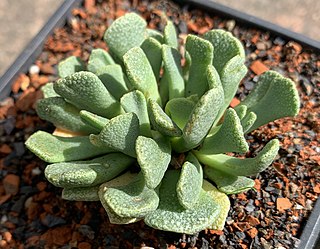
Aloinopsis spathulata is a species of succulent plant in the genus Aloinopsis native to South Africa. It has spoon-shaped green leaves patterned with tubercles, and unlike the yellow flowers of most in its genus, it has magenta to pink blooms. Able to grow in Sutherland, the coldest town in South Africa, it is particularly frost hardy.

Crassula ericoides is a species of succulent plant in the genus Crassula native to South Africa. Growing in the fynbos ecosystem of South Africa, C. ericoides somewhat resembles a heather, growing into an upright shrub with bare lower stems and yellow flowers at the tips.
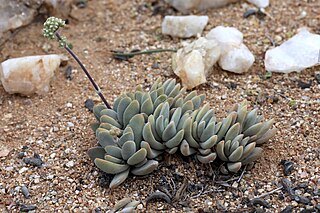
Crassula namaquensis is a species of succulent plant in the genus Crassula native to South Africa. Easily confused with some forms of Crassula tecta and Crassula sericea, this species has rounded to elongated leaves that are usually blue, covered in fine hairs, and form clumps.

Dracaena hallii is a species of succulent plant native to Mozambique, Zimbabwe, and Limpopo Province of South Africa. The species was named for Harry Hall, formerly the curator of succulents at Kirstenbosch National Botanical Garden in Cape Town. Commonly known as the "baseball bat" plant, it has extremely thick foliage with a rounded shape and a central channel.

Cheiridopsis speciosa is a species of plant from South Africa.
Cheiridopsis turbinata is a succulent plant from South Africa.
Cheiridopsis pilosula is a species of succulent plant from Namaqualand in the Northern Cape of South Africa.
Cheiridopsis ponderosa is a species of succulent plant from South Africa.


















